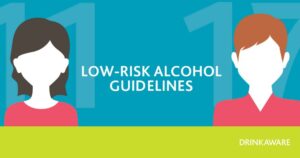Low Risk Weekly Alcohol Guidelines
Drinking within the low-risk weekly alcohol guidelines reduces your risk of alcohol-related health issues. But did you know that only 2% of Irish adults know the HSE low-risk weekly alcohol guidelines? This means that most of us don’t have a clear understanding of what alcohol misuse is. And we may be at-risk from experiencing harm as a result. Getting the facts on the low-risk weekly alcohol drinking guidelines can help you to know how much you’re really drinking in the week.
The low-risk weekly alcohol guidelines for adults are:
-
- Women: Less than 11 standard drinks (110g pure alcohol) spread out over the week, with at least two alcohol-free days
- Men: Less than 17 standard drinks (170g pure alcohol) spread out over the week, with at least two alcohol-free days
What is binge drinking?
Binge drinking (or heavy episodic drinking) is consuming six or more standard drinks in one sitting, usually in a short space of time. This is the equivalent of three pints of cider (568ml), six bottles of lager (330ml) or four glasses of prosecco (150ml). The term ‘binge drinking’ is not a colloquialism, it is a clinical definition used by the HSE and the World Health Organisation.
Our liver can process one standard drink per hour. When you binge, you’re drinking faster than your liver can handle. This means that the liver’s ability to process alcohol AND complete all the other essential functions it performs is affected.
In Ireland, binge drinking is widely considered to be the norm – 74% of Irish adults believe that excessive drinking is ‘just a part of Irish culture’. It is more common among men than women, and the under-25s. That said, binge drinking is still evident across all age groups.
Regular binge drinking or drinking more than the low-risk alcohol guidelines will increase risks to your health, wellbeing and safety. Risks include cancer, stomach disease, accidents, high blood pressure and depression.
Can I save these to drink in one sitting?
It is best to space any drinking out over the week as advised in the low-risk weekly alcohol guidelines. This gives your body a break and time to recover. Having at least two alcohol-free days in the week (more is even better) is good for your physical and mental health. This can also help to break the cycle of a habit that may be forming. Remember, these are guidelines – not a target. The less you drink, the lower your risk of developing alcohol-related health issues.
Is an Irish standard drink the same as a UK alcohol unit?
No. This is a really common source of confusion, particularly on labelling or packaging. However, it is important to remember that they are not the same. One UK unit contains 8 grams of pure alcohol, compared to 10 grams in one Irish standard drink.
Why does this matter?
Alcohol guidelines are typically set by the Department of Health in each country. If you see unit content displayed on a can or bottle label, this will show the alcohol content in a UK unit, not an Irish standard drink. For people in Ireland, the result will be an underestimation of how much alcohol was consumed. This means that you may be drinking more than the low-risk guidelines without realising. Remember drinking guidelines in Ireland are different from the guidelines in the UK and other countries, try to keep this in mind and always follow the guidance for Ireland.
What about children and teenagers?
The low-risk weekly alcohol guidelines are for adults only. There is no safe amount of alcohol for children. Early alcohol use can cause a range of harms including damaging brain development and future dependency. If a young person chooses to start drinking alcohol, it is strongly advised to wait until the legal drinking age of 18 years. An alcohol-free childhood is healthiest.
What is hazardous drinking?
Hazardous drinking is defined as when a person drinks over the recommended low-risk weekly drinking guidelines. It is also possible to drink hazardously by binge drinking (six or more standard drinks in one sitting), even if the drinking guidelines are adhered to. Health problems directly related to alcohol may not have been experienced yet, but there is an increasing risk of experiencing problems in the future.
When should I not drink alcohol?
Here are some instances when it is not safe to drink alcohol:
-
- if you are pregnant
- when caring for children
- before or while driving or cycling
- when operating machinery
- before or during swimming.
Always seek advice from your GP before drinking if you have a medical condition that may be worsened by alcohol or if you are on certain medication.

Try our drinks calculator today and see how your weekly drinking compares with the guidelines.

